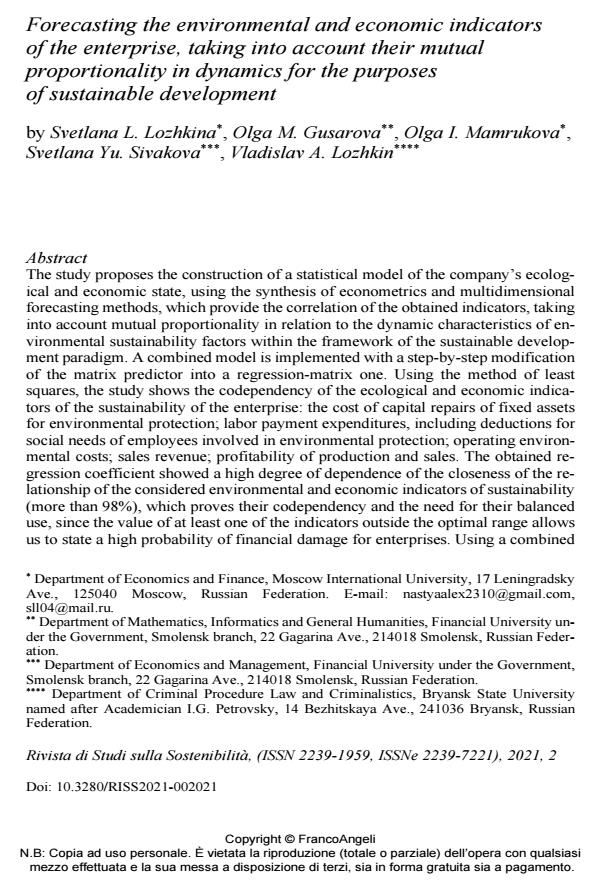Forecasting the environmental and economic indicators of the enterprise, taking into account their mutual proportionality in dynamics for the purposes of sustainable development
Titolo Rivista RIVISTA DI STUDI SULLA SOSTENIBILITA'
Autori/Curatori Svetlana L. Lozhkina, Olga M. Gusarova, Olga I. Mamrukova, Svetlana Yu. Sivakova, Vladislav A. Lozhkin
Anno di pubblicazione 2022 Fascicolo 2021/2
Lingua Inglese Numero pagine 19 P. 319-332 Dimensione file 180 KB
DOI 10.3280/RISS2021-002021
Il DOI è il codice a barre della proprietà intellettuale: per saperne di più
clicca qui
Qui sotto puoi vedere in anteprima la prima pagina di questo articolo.
Se questo articolo ti interessa, lo puoi acquistare (e scaricare in formato pdf) seguendo le facili indicazioni per acquistare il download credit. Acquista Download Credits per scaricare questo Articolo in formato PDF

FrancoAngeli è membro della Publishers International Linking Association, Inc (PILA)associazione indipendente e non profit per facilitare (attraverso i servizi tecnologici implementati da CrossRef.org) l’accesso degli studiosi ai contenuti digitali nelle pubblicazioni professionali e scientifiche
The study proposes the construction of a statistical model of the company’s eco-logical and economic state, using the synthesis of econometrics and multidimen-sional forecasting methods, which provide the correlation of the obtained indica-tors, taking into account mutual proportionality in relation to the dynamic charac-teristics of environmental sustainability factors within the framework of the sus-tainable development paradigm. A combined model is implemented with a step-by-step modification of the matrix predictor into a regression-matrix one. Using the method of least squares, the study shows the codependency of the ecological and economic indicators of the sustainability of the enterprise: the cost of capital repairs of fixed assets for environmental protection; labor payment expenditures, including deductions for social needs of employees involved in environmental pro-tection; operating environmental costs; sales revenue; profitability of production and sales. The obtained regression coefficient showed a high degree of dependence of the closeness of the relationship of the considered environmental and economic indicators of sustainability (more than 98%), which proves their codependency and the need for their balanced use, since the value of at least one of the indica-tors outside the optimal range allows us to state a high probability of financial damage for enterprises. Using a combined model based on a matrix predictor, the study demonstrates the calculation of the predicted values of environmental and economic indicators of sustainability for 2021.The peculiarity of this model is to take into account the lagging (up to 2 years) values of factors and their growth over the previous period (for 1 year). The proposed model contains a mechanism of multivariate expectations, which allows us to consider various options for the future. Also, this model allows the automation of the forecasting process, which is reflected in the implementation of the trend of transition to the digital space in the implementation of sustainable development goals.
Parole chiave:forecasting, environmental and economic indicators, combination, matrix predictor, sustainable development.
- Assessment and Forecasting of the Environmental Sustainability Statuses of Innovative Enterprises in the Context of Sustainable Development Mykola Odrekhivskyi, Uliana Kohut, Volodymyr Kolomatskyi, Natalia Horbal, Tomasz Wołowiec, Tetiana Dluhopolska, in Sustainability /2025 pp.3641
DOI: 10.3390/su17083641 - Financial assessment of the costs of exploration and evaluation of natural resources: Addressing environmental inequalities through sustainable mineral exploration and evaluation practices Farida Yerdavletova, Onaikhan Zhadigerova, Aliya Shakbutova, Myrzabike Zhumabayeva, Asset Kyzdarbekova, in RIVISTA DI STUDI SULLA SOSTENIBILITA' 2/2024 pp.71
DOI: 10.3280/RISS2024-002005
Svetlana L. Lozhkina, Olga M. Gusarova, Olga I. Mamrukova, Svetlana Yu. Sivakova, Vladislav A. Lozhkin, Forecasting the environmental and economic indicators of the enterprise, taking into account their mutual proportionality in dynamics for the purposes of sustainable development in "RIVISTA DI STUDI SULLA SOSTENIBILITA'" 2/2021, pp 319-332, DOI: 10.3280/RISS2021-002021